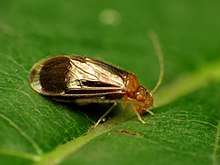Amphipsocidae
Amphipsocidae is a family of hairy-winged barklice in the order Psocoptera. Most species are 3.0-4.5 mm long and have many setae (hairs) on the veins and margin of the forewing. The main veins of the forewing are usually lined with two rows of setae.[1] Like the other members of the infra-order Caeciliusetae, they have a broad, flat labrum, with well defined edges.
| Amphipsocidae | |
|---|---|
.jpg) | |
| Polypsocus corruptus | |
| Scientific classification | |
| Kingdom: | Animalia |
| Phylum: | Arthropoda |
| Class: | Insecta |
| Order: | Psocoptera |
| Suborder: | Psocomorpha |
| Infraorder: | Caeciliusetae |
| Family: | Amphipsocidae |
| Subfamilies | |
| |
There are at least 19 genera and 240 described species in Amphipsocidae. These inconspicuous insects are widely distributed. The large genus Amphipsocus (98 named species) is found in the Afrotropics and eastern Asia. The genera Afropsocus, Capillopsocus, Ctenopsocus, Harpezoneura, Pentathyrsus, Schizopechus, and Xenopsocus are endemic to the Afrotropical region, whereas Complaniamphus, Pseudokolbea, Siniamphipsocus, and Tagalopsocus are endemic to eastern Asia. The genus Polypsocus is endemic to the Americas; Europe has two species, Kolbia quisquiliarum and Brachypsocus badonneli.[1]

Genera
These 21 genera belong to the family Amphipsocidae:
- Afropsocus c g
- Amphipsocopsis c g
- Amphipsocus c g
- Brachypsocus c g
- Calocaecilius c g
- Capillopsocus c g
- Complaniamphus c g
- Ctenopsocus c g
- Dasypsocus c g
- Harpezoneura c g
- Kodamaius c g
- Kolbia c g
- Pentathyrsus c g
- Polypsocus Hagen, 1866 i c g b
- Pseudokolbea c g
- Ptenopsila c g
- Schizopechus c g
- Siniamphipsocus c g
- Taeniostigma c g
- Tagalopsocus c g
- Xenopsocus c g
Data sources: i = ITIS,[2] c = Catalogue of Life,[3] g = GBIF,[4] b = Bugguide.net[5]
Sources
- Mockford, Edward L. (2018). Foottit, Robert; Adler, Peter (eds.). Biodiversity of Psocoptera. In: Insect Biodiversity: Science and Society, Volume II. John Wiley & Sons. p. 439. ISBN 1118945573.
- "Amphipsocidae Report". Integrated Taxonomic Information System. Retrieved 2018-05-03.
- "Browse Amphipsocidae". Catalogue of Life. Retrieved 2018-05-03.
- "Amphipsocidae". GBIF. Retrieved 2018-05-03.
- "Amphipsocidae Family Information". BugGuide.net. Retrieved 2018-05-03.
- Lienhard, C. & Smithers, C. N. 2002. Psocoptera (Insecta): World Catalogue and Bibliography. Instrumenta Biodiversitatis, vol. 5. Muséum d'histoire naturelle, Genève.
- Yoshizawa, Kazunori (2002). "Phylogeny and higher classification of suborder Psocomorpha (Insecta: Psocodea: 'Psocoptera')". Zoological Journal of the Linnean Society. 136 (3): 371–400. ISSN 0024-4082.
- Yoshizawa, Kazunori (2005). "Morphology of Psocomorpha (Psocodea:'Psocoptera')" (PDF). Insecta matsumurana. Series entomology. New series. Faculty Of Agriculture, Hokkaido University. 62: 1–44.